28.03.2007
I.Smykovsky. AEROFLOT-OPEN (A Review: Rounds 1-5)
Aeroflot Open is known to be the strongest Swiss system tournament in the world. The highest level of the main tournament participants, the very atmosphere of tough and uncompromising sportive struggle, when in order to get a prize one has to be in a rather big "plus",- all these factors guarantee solid ground for creative achievements and simply for interesting and instructive games. In this part of my review I intend to deal with the first part of the tournament. The opening disasters happen even on such a serious level. In the first round the attention was drawn to a quick and convincing win by Alexander Riazantsev. Shomoev (2556) – Riazantsev (2629) C11 1.e4 e6 2.d4 d5 3.¤c3 ¤f6 4.e5 ¤fd7 5.f4 c5 6.¤f3 ¤c6 7.Ґe3 Ґe7. Not the most popular, but safe enough variation of French Defense. The drawback of the move 7...Ґe7 is that after an exchange on c5 Black will lose a tempo taking with his bishop. 8.dxc5 8...O-O!? Following Morozevich's example the other players have also added this continuation to their arsenals. 9.Ґe2?! There are some doubts about this move, 9.Јd2 looks more versatile. Then it is possible to play 9.Јd2 Ґxc5 (9...¤xc5 10.a3 b6 11.Ґb5 Ґb7 12.O-O ¦c8 13.¦ad1ІKramnik – Morozevich, Monaco 2003) 10.O-O-O Јb6 11.Ґxc5 ¤xc5 12.Ґd3І with slight White's edge. 9...Ґxc5! In case of 9...¤xc5 White would have castled kingside with better chances. 10.Јd2?! As it turns out, after 10.Ґxc5 ¤xc5 the move 11.0-0 Јb6 is good for Black, but 11.Јd2 would have permitted to keep a rough equality. 10...Ґxe3 11.Јxe3 f6! The best move. Black has already seized the initiative, so there is no point in considering such variations as 11...¤dxe5?! 12.fxe5 d4 13.¤xd4 Јxd4 14.Јxd4 ¤xd4. 12.exf6. After refusing to capture White would have acquired the weakness on e5, and now Black wins tempi attacking the e3-queen. 12...¤xf6 13.¤d4. This permits Black to make his next move, but what can be done instead? On 13.0-0-0 there would follow 13...¤g4, and the f4-pawn hangs. 13...e5!N Alexander Riazantsev acts quite energetically and scores a big success. In the game Dominguez – Nogueiras (Havana 2006) the opponents had drawn after 13th White's move instead. 14.fxe5. After 14.¤xc6 bxc6 much too dangerous is 15.Јxe5 ¦e8 16.Јd4 Ґa6, and 15.Јc5 exf4 16.Јxc6 Ґf5 17.0-0-0 ¦c8 does not solve the problems as well. 14...¤g4 15.Ґxg4. In case of 15.Јd2 ¤cxe5 White has difficulties in finishing the development, but this is, most likely, just the way to play. 15...Ґxg4 16.¤xc6. White has no time to consolidate as well after 16.¤ce2 Јa5+ 17.c3 (17.Јd2 Јb6) 17...¦ae8. 16...bxc6 17.¤d1? A final mistake. There was still the way to defend himself by 17.¤e2. 17...d4! The outcome is clear – there is no way to hamper Black's attack. 18.Јg3 Јa5+ 19.c3 ¦ae8! 20.ўd2. If 20.Јxg4, then 20...Јxe5+ 21.ўd2 ¦f4! followed by 22...Јe2+ и 23...d3. 20...Ґh5 21.¦e1 ¦d8 22.ўc2 Ґg6+ 23.ўc1 Јa4 24.b3 Јa3+. On 25.¤b2 there follows 25...d3°, so White admitted defeat. 0-1 In the following two games the rating favorite of the tournament Vladimir Akopian practically did not have to strain himself. Everything was so simple that one might as well wonder whether he had mesmerized his opponents. Akopian (2700) – Safarli (2445) D72 1.d4 ¤f6 2.c4 g6 3.g3 Ґg7 4.Ґg2 d5 5.cxd5 ¤xd5 6.e4 ¤b6 7.¤e2 O-O 8.O-O ¤c6 9.d5 ¤a5 10.¤bc3 c6 11.¦e1!? More popular is 11.b3, but Vladimir Akopian has already employed the rook move, and successfully at that. His opponent seems not to know about it. 11...cxd5 12.exd5 e6?! Theory has it that 12...¤ac4 is safer. 13.¤f4 e5. In case of 13...exd5 14.¤fxd5 White has an advantage thanks to his strong centralized knight. 14.¤d3 ¤ac4 15.b3! A very promising exchange sacrifice. Akopian knew all that before, though. 15...e4. Black has no choice. 16.¤xe4 Ґxa1 17.bxc4 Ґg7. 17...¤xc4 18.Ґg5 f6 19.Ґh6 is unsatisfactorily as well. 18.Јb3 Ґf5 19.Ґg5 f6 20.Ґf4 Ґxe4N. A novelty that does not change the position's estimate. In Akopian – Shmuter (St. Petersburg 1993) there occurred 20...g5 21.Ґd2 ўh8 22.Ґb4 ¦e8 23.¤d6 ¦xe1+ 24.¤xe1 Јd7 25.c5 a5 26.Ґc3 ¤a4 27.Ґd4 Јe7 28.¤xf5 Јxe1+ 29.Ґf1 Јb4 30.Јe3, and Black resigned. 21.Ґxe4. Two bishops and the powerful pawn pair make Black's position undefendable. 21...g5 22.Ґd2 f5 23.Ґf3 ¦c8 24.c5. Pawns begin to advance, and the struggle soon ends. 24...¤d7 25.Ґb4. Also winning is 25.c6ќ. 25...f4 (25...a5 26.d6+ ўh8 27.Ґa3ќ) 26.d6+ ўh8 27.Ґxb7 fxg3 28.hxg3 ¦b8 29.c6 Јf6 30.¦e7 Јf3 31.Ґc3 Ґxc3 32.Јxc3+ ¤f6 33.d7 ўg8 34.Јb3+ ўh8 35.c7 1-0 Belov (2600) – Akopian (2700) C89 1.e4 e5 2.¤f3 ¤c6 3.Ґb5 a6 4.Ґa4 ¤f6 5.O-O Ґe7 6.¦e1 b5 7.Ґb3 O-O 8.c3 d5 9.d4 exd4 10.e5 ¤e4 11.¤xd4 ¤xe5 12.Ґf4 Ґf6. The opponents play a variation of Marshall Counterattack that is safe for Black. 13.Ґxe5?N. White can hardly find anything better than 13.f3 c5! 14.Ґxe5 Ґxe5 15.¤c6, allowing 15...Ґxh2+ 16.ўxh2 Јh4+ 17.ўg1 Јf2+= with a perpetual check. Curiously enough, this variation has already occurred in Vladimir Belov's practice. 13...Ґxe5 14.¤f3. Losing is 14.¤c6? Ґxh2+ 15.ўxh2 Јh4+ 16.ўg1 Јxf2+ 17.ўh2 (17.ўh1 Ґh3 18.¦g1 Јh4°) 17...Јg3+ 18.ўg1 Ґg4 19.¦e2 ¦ae8°. 14...Ґg4 15.Јxd5? In the variation 15.Ґxd5 Ґxf3 16.Јxf3 Јxd5 17.Јxe4 White has nothing to write home about, but still it is not losing outright. 15.¤bd2!? also permits to keep on fighting. 15...Ґxf3 16.Јxe5. It is possible to prolong the resistance by way of 16.gxf3 Ґxh2+! 17.ўg2 (17.ўh1 Јh4 18.Јxe4 Ґf4+ 19.ўg2 Јh2+ 20.ўf1 Јh3+°) 17...Јg5+ 18.Јxg5 ¤xg5 or16.Јxd8 ¦axd8 17.gxf3 ¤g5 18.ўg2 Ґxh2. 16...Јh4! White is helpless, he has to cede the exchange. 17.¦xe4 Јxe4 18.Јxe4 Ґxe4 19.¤d2 Ґb7 0-1 And now an example of a crushing novelty. The regular employment of the same opening system has its swings and roundabouts. In this particular case Ian Nepomniachtchi fell victim to excellent preparation of a strong Spanish GM. Nepomniachtchi (2587) – Vallejo (2679) C22 1.e4 e5 2.d4. Ian used to employ an old Central Game more than once lately. 2...exd4 3.Јxd4 ¤c6 4.Јe3 ¤f6. In the game Nepomniachtchi – Sargissian played in the same tournament there occurred 4...g6 5.Ґd2 Ґg7 6.¤c3 d6 7.O-O-O ¤f6 8.h4 with complex play; in the same groove proceeded the game Nepomniachtchi – Tomashevsky (Moscow 2006). 5.¤c3 Ґb4 6.Ґd2 O-O 7.O-O-O ¦e8 8.Јg3 ¤xe4!? In theory 8...¦xe4 is considered more precise. In Nepomniachtchi – Harikrishna there followed 9.a3 Ґd6 10.f4 ¦e8 11.Ґd3 Ґf8 12.¤f3 d6 13.f5 d5 14.¦he1©. Vallejo has examined the creative work of his opponent thoroughly and prepared a knock-me-down novelty. 9.¤xe4 ¦xe4 10.Ґf4 Јf6 11.¤h3 d6 12.Ґd3 ¤d4 13.ўb1. 13.Ґe3 ¦g4! is not promising, and this has been known since the game Mieses – Capablanca, Berlin 1913. 13...¤e2 14.Јf3 14...Ґa3!N. Previously occurred only 14...¦xf4? 15.¤xf4 ¤xf4 16.Јe4 g6 17.Јxb4 ¤xd3 18.¦xd3 Јxf2 19.¦d2 Јb6 = Rabadan – Morgado (Argentina 1971). Perhaps Nepomniachtchi intended to fortify the play by way of 18.cxd3! Јxf2 19.¦he1, and if 19...Ґf5, then 20.Јxb7 Ґxd3+ 21.ўa1 ¦f8 22.Јf3±. After 14...Ґa3! White's number has come up. 15.bxa3. The chances to escape are negligible as well in case of 15.Ґc1 Јxf3 16.gxf3 ¦e5 17.f4 ¦e8 18.Ґxe2 Ґxh3. 15...¤c3+ 16.ўc1 ¤xa2+ 17.ўb1 ¤c3+ 18.ўc1 Ґxh3 19.Ґxe4 19...Ґxg2! The final blow. 20.Јxg2 Јxf4+ 21.ўb2 ¤xe4. Black's position is completely won; no further comment is necessary. 22.¦d4 Јf6 23.Јxe4 c5 24.¦e1 h5 25.Јf4 Јxd4+ 26.Јxd4 cxd4 27.¦e7 b6 28.a4 g5 29.ўb3 ўg7 30.¦c7 ¦e8 31.¦xa7 ¦e2 32.¦b7 ¦xf2 33.¦xb6 ¦xh2 34.a5 ¦e2 35.a6 ¦e8 36.a7 ¦a8 0-1 Yury Yakovich managed to launch a fine attack on the king with a piece sacrifice. Only deep and thorough analysis can clarify whether his opponent has had adequate defensive opportunities. Yakovich (2577) – Naiditsch (2663) D93 1.d4 ¤f6 2.c4 g6 3.¤c3 d5 4.Ґf4 Ґg7 5.e3 c5 6.dxc5 Јa5 7.¦c1 dxc4 8.Ґxc4 O-O 9.¤f3 Јxc5 10.Ґb3 ¤c6 11.O-O Јa5 12.Јe2. More frequently there occurs 12.h3 securing the h2-square for a bishop. 12...¤h5 13.Ґg5 h6?! Simpler is 13...Ґg4 14.Ґh4 Јb4! 15.Јc4 Јxc4 16.Ґxc4 Ґxf3 17.gxf3 Ґf6 = Jussupow – Leko (Essen 2002). 14.Ґh4 g5 15.¦fd1 e6. If 15...gxh4?, then 16.¦d5±. 16.Ґg3 ¤xg3 17.hxg3 b6!?N. After 17...¦d8 18.¤e4 Ґd7 19.¤d6 Black faced problems in the game Jussupow – Anand (Wijk aan Zee 1994). 18.¤e4 ¤e5?! Underestimating the opponent's offensive potential. A logical continuation would be 18...Ґa6 19.Ґc4 Ґxc4 20.Јxc4 ¤e5 with chances for leveling. 19.¤fxg5! This move unconditionally deserves an exclamation point for courage, but a good alternative is 19.¤xe5!? Ґxe5 (on 19...Јxe5 the promising-looking variation is 20.¤d6 Јxb2 21.Јd3©) 20.Јh5! Now losing is 20...ўg7? 21.f4! Ґxb2 (21...gxf4 22.Ґd5! Ґxb2 23.Јg4+ ўh7 24.Ґxa8 Ґxc1 25.¦xc1ќ) 22.fxg5 hxg5 23.¦c5! bxc5 24.Јxg5+ ўh7 (24...ўh8 25.Јh6+ ўg8 26.¤g5ќ) 25.¤f6+ Ґxf6 26.Ґc2+ќ . The variations 20...Ґg7 21.¦c7± or 20...Ґxb2 21.¦c7 Јe5 22.¤d6© do not allow to get off the hook. 19...hxg5. If 19...Ґa6, then 20.Јh5 Ґd3! (20...¤d3? 21.¦c7 hxg5 22.¤xg5 Јf5 23.e4 Јg6 24.Јxg6 fxg6 25.¤xe6ќ) 21.¦c3! hxg5 22.¦cxd3 ¤xd3 23.Ґc2! (a brilliant resource, much less effective is 23.¤xg5 Јf5 24.Ґc2 ¦fd8 25.Ґxd3 ¦xd3 26.¦xd3 Јxd3 27.Јxf7+ ўh8 28.Јh5+ ўg8=) 23...¦fd8 24.Ґxd3, and Black faces a difficult defense. Also losing is 24...f6? 25.¤xf6+! Ґxf6 26.Јg6+ Ґg7 27.Јxe6+ ўf8 (27...ўh8 28.Јh3+ ўg8 29.Ґc4+ ўf8 30.Јe6) 28.Ґc4! ¦xd1+ 29.ўh2 ¦h1+ 30.ўxh1 Јe1+ 31.ўh2 Јxf2 32.Јg8+ ўe7 33.Јxg7+ ўd6 34.Јd4+ ўc7 35.Јe5+ќ, and on 24...¦d5 there follows 25.¤d6! ¦xd6 26.Ґh7+ ўf8 27.¦xd6 Јe1+ 28.ўh2 Јxf2 29.¦d7 with white initiative. 20.¤xg5 Ґh6 (20...¤d7? 21.¤xe6!ќ) 21.Јh5 Ґxg5? The only defense is 21...ўg7! 22.¦c7 Ґxg5 23.Ґc2! (23.Јxg5+ ¤g6) 23...¤d7! (less strong is 23...Ґh6?! because of 24.¦d4! with at hreat of 25.¦g4+! ¤xg4 26.Јg6+! – and then it is possible to play 24...¤d7 25.¦g4+ ўf6 26.Јxh6+ ўe7 27.Јh4+ ўe8?! 28.¦a4! Јe1+ 29.ўh2 f5 30.¦d4ќwith subsequent Ґa4 or 27...f6 28.¦d4‚ with a strong attack) 24.Јh7+ (24.¦dxd7 Ґxd7 25.¦xd7 ўf6 26.Јf3+ ўg7 27.Јh5=) 24...ўf6 25.f4 ўe7 26.Јe4 ¦b8 27.b4 Јb5 28.a4 Ґxf4! 29.exf4 Јh5› with unclear consequences. I cannot rule out the possibility that White's play can be fortified somewhere. 22.Ґc2! This nice intermediate move ensures White's success. 22...ўg7. On 22...¦e8 there would also follow 23.b4! with subsequent 23...Јb5 24.Јxg5+ ўf8 25.Јh6+ ўe7 (25...ўg8 26.Ґh7+ ўh8 27.Ґd3+) 26.Јh4+ f6 (26...ўf8 27.a4ќ) 27.Ґg6!ќ. 23.b4! Black resigned as neither 23...Јxb4 24.Јxg5+ ¤g6 25.Ґxg6 fxg6 26.¦c7+ ¦f7 27.Јe5+ nor 23...¤f3+ 24.gxf3 Јe5 25.f4 Ґxf4 26.Јh7+ ўf6 27.exf4ќ can save him. 1-0 Alexey Korotylev succeeded in a typical for opposite side castlings attack. Here the piece sacrifice was also present; it is much easier to estimate its consequences, though. Safarli (2445) – Korotylev (2615) With his last move White has captured the knight on h5 and reckons on obtaining counterplay on the K-side after 23...gxh5 24.f5 or 24.g6. But Alexey Korotylev gives his opponent no such chance. 23...b4! An attack is much more important than a piece. 24.Ґe2.On 24.f5 the issue is also decided by 24...¤xb2! 24...¤xb2! 25.ўxb2 bxc3+ 26.ўa2.The attempt to keep the extra material also leads to the mate: 26.ўa1 a4 27.¤c1 Јc5 28.¤a2 Јxa3 29.¦b1 ¦b2°. 26...a4 27.¦d4. Hopeless as well is 27.¦b1 axb3+ 28.¦xb3 Ґa4°. 27...axb3+ 28.cxb3 d5! 29.exd5 Јa7 30.d6 Јxd4 31.dxe7 ¦xb3!White resigned in view of 32.ўxb3 Јa4+ 33.ўa2 Јc2+ with checkmate. 0-1 The opposite example. Armenian GM Zaven Andriasian has firstly accepted donations offered by Emil Sutovsky and then coolly parried the opponent's threats. Sutovsky(2629) – Andriasian (2508) B86 1.e4 c5 2.¤c3 d6 3.¤f3 ¤f6 4.d4 cxd4 5.¤xd4 a6 6.Ґc4 e6 7.Ґb3 ¤bd7 8.Ґg5 ¤c5 9.f4 Ґe7 10.Јf3 Јc7 11.O-O b5 12.f5 b4 13.fxe6 bxc3 14.exf7+. In Leitao – Panno (Santiago 2004) there occurred 14.¤f5, and after 14...¤xb3? 15.¤xg7+ ўd8 16.cxb3 White has won quickly, though in case of the correct move 14...cxb2! the position remains completely unclear. 14...ўf8 15.¦ae1?N. Looks like a decisive mistake. Probably, Sutovsky has underestimated his opponent's 16th move. To a tangle leads 15.e5 dxe5 16.Јxa8 exd4› (but not 16...cxb2? 17.¦ae1 exd4 18.¦xf6!ќKomiagina – Lupik, Moscow 2006) or 15.Јxc3 ¤fxe4 16.Ґxe7+ Јxe7 17.Јa5›. 15...¤xb3 16.axb3 cxb2! The far advanced pawn limits White's possibilities. 17.ўh1. There is no compensation for a piece offered. After 17.e5 dxe5 18.Јxa8 exd4 19.Ґxf6 gxf6 Black has great advantage as well. 17...¦b8 18.Ґh6. A sacrifice of despair, after which all Black needs is minimal accuracy. After any other move Black would have played 18...ўxf7, made an artificial castling and utilized his material advantage easily. 18...gxh6 19.Јf4 ¤g4 20.¤f5 Ґxf5 21.exf5 ¤f6 22.¦e6 ¦b5 23.g4 ўxf7 24.Јxh6 Јc6+ 25.ўg1 ¦g8 26.g5 Јc5+ 27.ўh1 Јd5+ 28.ўg1 Јxf5! 0-1 Dmitry Svetushkin outplayed Ilia Smirin in fine style. I think that this game is of theoretical importance as well. Svetushkin(2588) – Smirin(2654) B51 1.e4 c5 2.¤f3 d6 3.Ґb5+ ¤c6 4.O-O Ґd7 5.¦e1 ¤f6 6.c3 a6 7.Ґa4 c4 8.¤a3!? The interest in this move has been aroused only recently. Previously more frequently the moves 8.d4 and 8.Ґc2 were employed, but without much success at that. 8...b5 9.Ґc2 Ґg4 10.h3 Ґh5 11.b3. White undermines the advanced pawn and obtains pawn dominance in the center. 11...cxb3 12.axb3 e5 13.d4! exd4N. Surrendering the center is always an important decision. In Bojkov – Wojtaszek (Ermioni 2006) there occurred 13...Ґe7 14.d5 ¤a7 15.Ґd3 Јc7 16.Ґd2 O-O – later on Black won, but I don't think that he had been quite satisfied with the opening results. White's position is even slightly preferable. 14.cxd4. Another way – 14.g4!? is interesting as well. 14...Ґxf3 15.gxf3 Ґe7 16.d5 ¤e5? The punishment for this move would not be long in coming. It was necessary to play 16...¤b4, although after 17.Јd2!? (White would have been glad to retain the bishop by way of 17.Ґb1, but then 17...Јd7) 17...¤xc2 18.¤xc2 the weakness of light-colored squares is quite telling. 17.f4 ¤g6 18.e5! An effective breakthrough in the center, the consequences of which have been precisely calculated. 18...dxe5 19.d6! Јxd6 20.Јxd6 Ґxd6 21.fxe5 Ґb4. Otherwise a piece is lost: 21...¤xe5 22.Ґb2ќ. 22.exf6+ Ґxe1 23.fxg7 ¦g8 24.Ґb2. Black is an exchange up, but his position is absolutely hopeless. The g7-pawn is very strong; moreover the e1-bishop hangs, there is a threat of the knight taking on b5, and black king is posted badly. 24...Ґa5. None the better is 24...Ґb4 25.¤xb5 ¦c8 (25...ўd7 26.Ґe4 ¦ab8 27.¦xa6) 26.Ґf5 ¦c5 27.¦xa6ќor 24...Ґd2 25.¤xb5 Ґf4 26.Ґf6ќ. 25.Ґe4 ¦a7. If the rook retreats from the a-file, then a capture on b5 follows: 25...O-O-O 26.¤xb5 ¦d2 27.Ґf6 Ґb6 28.¦xa6 Ґxf2+ 29.ўf1ќ. 26.¤c2 Ґb6 (26...Ґd8 27.Ґc6+ ўe7 28.Ґd4 ¦c7 29.¤b4 ¤f4 30.Ґe5ќ) 27.¤b4? White is a bit too much relaxed and could have run into considerable troubles in converting his advantage because of this. He should have blockaded the pawn on f7 by way of 27.Ґf6! ўd7 (27...¦c7 28.¦xa6) 28.Ґf5+ ўc7 29.¤b4ќwith completely won position. 27...f5. Black acquires an opportunity to give back an exchange for the passed g7-pawn. The move 27...f6!? with the same idea also deserves attention. 28.Ґc6+. Also after 28.Ґxf5 ¦gxg7 29.Ґxg7 ¦xg7 30.¦xa6 Ґc5 everything is not so simple at all. 28...ўd8 29.ўf1 29...¤e7? A decisive blunder. Much more stubborn is 29...¦gxg7 30.Ґxg7 (30.Ґf6+!? ¦ge7 31.¤d5 Ґc5 32.b4 Ґd6 33.Ґxb5 Ґe5) 30...¦xg7 31.¦xa6 (31.¤d5 ¤e7) 31...ўc7 32.Ґxb5 ¤f4. 30.Ґf6! It is all over now. 30...ўc8 31.Ґf3 a5 32.¦c1+ ўd7 (32...¦c7 33.¦xc7+ Ґxc7 34.¤c6 ¤xc6 35.Ґxc6ќ) 33.¤d5 ¤xd5 34.Ґxd5 ¦aa8 35.Ґxa8 ¦xa8 36.Ґd8! 1-0 Dmitry Jakovenko won an integral positional game. As in the previous example at the crucial moment of the game White sacrifices an exchange. Jakovenko (2691) – Hou Yifan (2509) B66 1.e4 c5 2.¤f3 d6 3.d4 cxd4 4.¤xd4 ¤f6 5.¤c3 ¤c6 6.Ґg5 e6 7.Јd2 a6 8.O-O-O ¤xd4 9.Јxd4 Ґe7 10.f4 b5 11.Ґe2 Ґb7 12.Ґf3 ¦c8 13.Ґxf6 gxf6 14.ўb1 14...¦c5N. A novelty. Previously occurred 14...0-0 and 14...¦с4. 15.¦he1 Јc7 16.f5 O-O 17.¦e3! White intends restructuring his pieces: Јd2, ¤e2, ¦d3 with subsequent transfer of the knight via g3 or f4 to h5 and queen's lunge to h6. 17...ўh8?! Black fails to hamper the opponent's plans. It should have been played 17...¦c4 18.Јd2 b4 19.¤e2 ¦c8 exerting pressure on the c2-pawn. 18.Јd2 ¦g8 19.¤e2 Ґf8 20.¦d3 ¦e5 21.¤g3 Ґe7. Black position has inconspicuously become difficult. It is hard to prevent queen's invasion to h6. Of no help as well is the variation 21...¦g5 22.¦c3! (if immediately 22.¤h5, then 22...Ґxe4! 23.¤xf6 Ґxd3), and on 22...¦c5? there follows 23.¦xc5 Јxc5 24.e5! Ґxf3 25.gxf3±. 22.Јh6 Јd8 23.¦xd6! A sacrifice of an exchange destroys black pawn structure. 23...Ґxd6 24.¦xd6 Јf8. After 24...Јxd6 25.Јxf6+ ¦g7 26.¤h5 Јf8 27.Јxe5 f6 28.Јxe6 White grabs a whole lot of pawns. 25.Јxf6+ Јg7 26.Јxg7+ ўxg7 27.ўc1. White has two pawns for an exchange and a significant advantage in the ending, largely due to an active rook. On the stage of converting his advantage Dmitry Jakovenko is irreproachable. 27...¦c8 28.¦d7 Ґc6 29.¦a7 ¦a8 30.¦c7 Ґe8 31.¤h5+ ўf8 32.f6! White's idea is to loosen the position on both flanks in accordance with the principle of two weaknesses. 32...b4 33.¤f4 ¦a5 34.ўb1 ¦b8 35.¤d3 e5. Now this pawn becomes weak, but otherwise White would have carried out e4-e5 himself. 36.g4 h6 37.h4 ¦ab5 38.g5 hxg5 39.hxg5 ¦8b7 40.¦c4 a5 41.b3 ¦7b6 42.a4 bxa3 43.ўa2 ¦b8 44.ўxa3 Ґd7 45.¦c7 Ґe8. On 45...Ґh3 there is a very strong reply 46.Ґh5 Ґe6 47.¤c5ќ. 46.Ґg4 ¦8b7 47.¦c4 ¦b8 48.Ґf5 ¦d8 49.¦c7. Now the e5-pawn is inevitably lost. 49...¦db8 50.¦e7 ¦8b7 51.¦xb7 ¦xb7 52.¤xe5 ¦b8 53.c4 ¦d8 54.c5 ¦d1. In case of 54...¦d2 55.c6 ¦c2 winning is 56.Ґd7 ¦c5 (56...¦c1 57.Ґxe8 ўxe8 58.ўb2 ¦c5 59.g6! ¦xe5 60.c7 ўd7 61.gxf7ќ) 57.¤c4!ќ, and Black is in zugzwang. 55.c6 ¦c1 56.ўb2. Black resigned, as after 56...¦c5 57.¤d7+ Ґxd7 58.cxd7 the pawn queens.1-0 Viorel Iordachescu, playing against Sergey Volkov in his usual active manner, sacrificed a pawn for the initiative. This game is interesting for the theory of French Defense and also shows an example of the attack in the position with bishops of opposite color. Iordachescu (2563) – Volkov (2636) C03 1.e4 e6 2.d4 d5 3.¤d2 ¤f6 4.e5 ¤fd7 5.Ґd3 c5 6.c3 ¤c6 7.¤gf3!? White immediately demonstrates his aggressive intentions and readiness to sacrifice a pawn in case of 7...Јb6 8.0-0. 7...Ґe7 8.O-O g5. The idea of g7-g5 has been known for a long time, but it is associated with considerable strategic risk. This particular game proves it once again. 9.dxc5 ¤dxe5 10.¤xe5. More often the bishop is retained by the move 10.Ґb5, but Iordachescu strives to mobilize as quickly as possible. 10...¤xe5 11.¤b3 Јc7N. Previously occurred 11...Ґd7 and 11..¤xd3. 12.f4! A key idea. White intends to obtain bishops of opposite color, keeping in mind that this factor intensifies the attack sharply, and the enemy king feels uncomfortably. 12...Ґxc5+ 13.¤xc5 Јxc5+ 14.¦f2! This is much more precise than 14.ўh1 ¤xd3 15.Јxd3 Ґd7. 14...¤xd3 15.Јxd3 g4. Naturally Black avoids opening up. On 15...Јc4 there would follow 16.Јg3. 16.b3. Preventing Јc4 and with c3-c4 already in mind. 16...Ґd7 17.Ґe3 Јb5 (17...Ґb5?! 18.c4 dxc4 19.Јc3 Јf8 20.Јe5ќ) 18.Јd4 ¦g8 19.f5! Widening the range of the dark-squared bishop. 19...exf5 20.Јe5+. White lets the king to the Q-side seeing that it will be ill at ease there too. On 20.Ґg5 (counting on на 20...¦xg5?! 21.Јh8+ ўe7 22.Јxa8 Јb6 23.¦e1+ Ґe6 24.Јb8) Black would have played 20...Ґe6. 20...Ґe6 21.¦xf5 O-O-O 22.¦f2 a6 23.Ґf4 Јc6 24.¦d1. White initiative is strong, but Black is still able to defend himself. As for now the c- pawn advance is on the agenda. 24...b5. Vacating a square for the king. Worth attention is 24...h5!? 25.c4 (25.Јxh5? g3! 26.Ґxg3 Ґg4) 25...f6 26.Јb8+ (26.Јxf6 dxc4) 26...ўd7 27.Јa7 ўe7. 25.c4! White implements his plans consistently. It becomes harder and harder for Black to hold the line, but nevertheless this is still possible. 25...ўb7 26.cxb5 Јxb5?! Stronger are both 26...axb5 27.¦c1 Јb6 and 27.a4 ¦c8 28.axb5 Јxb5; but, most likely, only a computer would be equal to the task of holding this position against a strong GM. 27.a4 Јd7 28.¦d4 Јe7 29.Јe1! A fine geometric motif. 29...ўa8 30.Јe2. Less convincing is 30.Јa5 Јa7 31.Ґe3 ¦ge8 32.¦e4 d4 33.¦xd4 ¦xd4 34.Ґxd4 Јb7. 30...Јa7 31.Ґe3 Ґc8 [31...¦ge8? 32.¦b4 d4 33.Ґxd4! ¦xd4 34.¦xd4 Јxd4 35.Јxa6+ ўb8 (35...Јa7 36.Јc6+) 36.Јb5+ќ] 32.Јd2 ¦ge8 33.¦f1 Јb6 34.Ґf2 ¦e4 35.b4?! White turns down taking on d5 without reason. After 35.¦xd5 ¦xd5 36.Јxd5+ Јb7 37.Јc5 ¦e8 38.b4 Black is in for hard times. 35...f5 36.b5 36...h5?! Much more stubborn is 36...Ґb7! 37.¦xe4 dxe4 38.Јg5 Јd6 39.Јxf5 Јd5, and if 40.Јxg4, then 40...¦g8 41.Јe2 ¦xg2+ 42.ўxg2 e3+ 43.ўh3 (43.ўg3 Јg2+ 44.ўf4 Јe4+=) 43...Јg2+ 44.ўh4 Ґc8! 45.Јc4 Јh3+ 46.ўg5 Јf5+= with perpetual check. 37.¦d1! Now Black has no time to organize his defense. In case of straightforward 37.¦xd5 ¦xd5 38.Јxd5+ Јb7 39.Јg8 (39.Јc5 ¦xa4 40.b6 ¦e4 41.¦d1 ¦e8) there is still a possibility to hold on with the help of the only move 39...Јb8! 40.¦c1 Ґb7. 37...Јe6 38.¦xe4 fxe4 (38...Јxe4 39.Јa5 Јc2 40.¦e1 ¦d6 41.Ґe3 Ґb7 42.Ґf4 Јc5+ 43.ўh1ќ) 39.Јd4 Јe7 40.¦c1. White pieces inexorably pursue their aim. 40...¦e8 41.Ґe3 Јd7 42.¦c6 h4 43.Јb6 Јb7 44.Јc5 Јb8 45.¦c7 1-0 St. Petersburg player Evgeny Alekseev employed an old gambit variation, an interest in which had been noticeably reviving these days. A strong novelty allowed him to seize the initiative right in the opening, and he had never lost it until the end of the game. Ehlvest (2610) – Alekseev (2661) E10 1.d4 ¤f6 2.c4 e6 3.¤f3 c5 4.d5 b5!? It looks like Blumenfeld Gambit gradually returns into serious tournament practice. 5.dxe6. 5.Ґg5 is considered more precise, but now there is no point in going into theoretical discussions. 5...fxe6 6.cxb5 d5 7.¤c3 ¤bd7 8.e4 d4 9.e5 ¤g4 10.¤e4 10...Ґb7!N. A strengthening. Previously occurred 10...¤dxe5 11.¤xe5 ¤xe5 12.Јh5+ ¤f7 13.¤xc5 with white advantage. 11.Јe2 (11.¤xd4? ¤dxe5) 11...Ґd5. Black bishop dominates the center, and the e5-pawn keeps on hanging. 12.¤xd4. White forces the play taking great chances at that. It is worth attention 12.b3!?, in order after 12...¤gxe5 13.¤xe5 ¤xe5 14.Јh5+ ¤g6 15.Ґd3 to deprive Black of c5-c4, although to take on e5 is surely not obligatory. 12...cxd4 13.Јxg4 ¤xe5 14.Јh5+ ¤g6 15.Ґd3 Ґb4+! 16.ўe2. In Black's favor is 16.Ґd2?! Ґxe4! 17.Ґxe4 Ґxd2+ 18.ўxd2 O-Oµ, but it will be interesting to examine 16.ўf1!? 16...Јc7 17.a3?! White cracks under the strain and practically loses a tempo: it is advantageous for the black bishop to return on e7 in order to take the g5-square under control and to prepare the K-side castling. White should have played 17.¦d1 with subsequent 18.ўf1 and the following complex play. 17...Ґe7 18.Ґd2? After this mistake it becomes impossible to save the game. The correct way is 18.¤g5! Ґxg5 19.Ґxg6+ hxg6 20.Јxg6+ (20.Јxh8+? ўf7 21.Јh3 Јc2+°) 20...ўf8, and now not 21.Ґxg5? Јe5+ 22.ўd2 (22.ўf1? Ґe4°) 22...d3!µ, but 21.Јxg5! Јc4+ 22.ўe1 Јxb5 23.f3, retaining an extra pawn and defensive resources. 18...O-O 19.¦hc1 Јb7 20.f3 20...¦f5! Evgeny Alekseev wages a vigorous attack and does not leave his opponent a chance. 21.Јh3 ¤e5 22.a4 ¤xd3 23.ўxd3 a6 24.Јg3 e5 25.Ґa5 Ґxe4+. Also winning is 25...axb5 26.¦c7 Јa6°. 26.fxe4 ¦f4 27.Јe1 axb5 28.Ґd2 ¦ff8 29.a5 b4 30.b3 Јb5+ 31.¦c4 ¦xa5 32.¦xa5 Јxa5 33.Јc1 Јa6 34.Јd1 h6 35.Јg4 ўh7 36.Јd7 Јa2 0-1 How to obtain an advantage with White in Gruenfeld Defense? It is a problem for many a chessplayer. Let's see how a young Czech GM Victor Laznicka does it. Laznicka(2593) – Areshchenko (2644) D70 1.d4 ¤f6 2.c4 g6 3.f3. One of the anti-Gruenfeld ideas that usually lead to a complex and eventful struggle. 3...d5 4.cxd5 ¤xd5 5.e4 ¤b6 6.¤c3 Ґg7 7.Ґe3 O-O 8.Јd2 e5 9.d5 c6 10.h4 cxd5 11.exd5 ¤8d7 12.h5 ¤f6 13.hxg6 fxg6 14.d6!N. White is in no hurry with castling, as it used to occur previously. When the king is in the center it is often more difficult for Black to develop his counterplay; and, for that matter, the d6-pawn is a formidable force, holding the opponent's pieces. 14...Ґe6?! The threat of a knight's leap to d5 turns out ungrounded, and the e6-bishop is vulnerable. More preferable is the modest 14...Ґd7 15.¤h3 ¦c8 or, vice versa, the super-active 14...e4!? 15.fxe4 ¦e8 16.Јd3 ¤g4, although there is a feeling that White's chances are better anyway. 15.¤h3 Ґxh3. Conceding the bishop pair to White. Black cannot be satisfied either with 15...¤bd5? 16.¤g5 ¤xe3 17.¤xe6 Јb6 18.¤a4ќ or with 15...¤c4 16.Ґxc4 Ґxc4 17.¤g5±. 16.¦xh3 ¦c8 17.Ґg5. Premature is 17.¦h4 ¤e8! 17...Јd7 (17...¤c4? 18.Ґxf6 Јxf6 19.Јd5+ Јf7 20.d7ќ) 18.¦h4! And now it is just the right time for this move. White has taken control over the 4th rank and surely obtained a solid advantage. 18...Јe6. Black's play should be based on the e5-e4 advance, although White is well-prepared for opening-up in the center, for instance 18...e4 19.¤xe4 Јe6 20.¦d1 Јxa2 21.¤xf6+ (21.¤c3!?)21...Ґxf6 22.Ґxf6 ¦xf6 23.ўf2±. 19.¦d1 ¦f7?! Black should have brought himself to play 19...e4 20.¤xe4 (see the previous remark), be it good or bad for him. 20.a4. Interesting is 20.ўf2!? 20...Јb3. The queen is almost surely perishes, but nothing is gained by 20...e4 21.¤xe4 ¤xa4 22.Ґe3!± as well . 21.a5 ¤bd7 (21...¤c4 22.Ґxc4 ¦xc4 23.¦xc4 Јxc4 24.¦c1±) 22.Ґd3 e4. Too late, but there is nothing better already. 23.Ґb1! Stressing the fact that there are too many black pieces on the a2-g8 diagonal. The game enters the stage of complications that are advantageous for White. 23...exf3 24.Ґa2. The queen is trapped, but still everything is not so simple. Less critical but equally strong is 24.ўf1. 24...fxg2 25.Ґe3 g1Ј+?! More problems would have been raised by 25...¦e8 26.ўe2 ¦xe3+ (26...Јxa2 27.¤xa2 Ґh6 28.¦xh6 ¤g4 29.¦g1 ¦f2+ 30.ўd3 ¤de5+ 31.ўc3 ¦c8+ 32.ўb3ќ) 27.Јxe3 Јc2+ (27...Јxb2+ 28.Јd2 Јxd2+ 29.ўxd2 Ґf8 30.¦g1) 28.Јd2 Јf5 29.Ґxf7+ ўxf7 30.Јd3 Јxa5 31.Јc4+ ўf8 32.ўf2ќ, and White gradually converts his extra material. 26.Ґxg1 ¦e8+ 27.Ґe3 ¦xe3+ 28.Јxe3 Јxb2 29.¦h3? Until this moment White has acted efficiently, but now he makes a mistake that could have deprived him of a deserved win. Winning simpler is 29.¦f4. 29...h5?! Both opponents fail to take into account the variation 29...¤d5!! 30.¤xd5 (30.Јe8+ ¤f8 31.Јxf7+ ўxf7 32.Ґxd5+ ўe8) 30...Јxa2› with absolutely unclear consequences. 30.Јe6 ¤d5! Here this is also correct, but the effect has already been a bit spoiled. 31.¦f3! Ґxc3+ 32.ўf1 ¤e3+ 33.Јxe3 Јxa2 34.Јxc3. As a result of a tactical skirmish White has an exchange for two pawns and chances to win due to a strong passed pawn. 34...Јa4? A decisive mistake. Black should have taken another pawn by way of 34...¦xf3+ 35.Јxf3 Јxa5. White has no time to play 36.¦e1? because of 36...Јa6+, and so his victory is up in the air. 35.¦e1! The rook takes an active position and thus decides the issue. 35...Јb5+ 36.¦e2! (36.ўg1? ¦xf3 37.Јxf3 Јc5+=) 36...¤e5. Not helpful is 36...¦f5 37.¦xf5 Јxf5+ 38.ўe1 Јb1+ 39.ўd2 Јa2+ 40.ўd3 Јd5+ 41.Јd4 ¤c5+ (41...Јb3+ 42.ўd2 Јa2+ 43.ўe1 Јxa5+ 44.ўd1ќ) 42.ўc3 Јb3+ 43.ўd2 ¤e6 44.Јe5ќ. 37.¦xf7 ¤xf7 38.Јc8+. Simpler is 38.Јd4! 38...ўg7 39.Јc3+ ўh6 40.Јd2+ ўg7 41.Јd4+ ўh6. 41...ўh7 42.d7 Јf5+ 43.¦f2 Јh3+ 44.ўe1 ¤d8 (44...Јe6+ 45.¦e2ќ) 45.¦f8 Јh1+ 46.ўd2ќonly drags out the resistance– white king finds a shelter from checks on the a4-square. 42.d7 b6 (42...Јf5+ 43.¦f2 Јh3+ 44.ўe2 Јe6+ 45.Јe3+ќ) 43.d8Ј 1-0 Games played at the first table are always characterized by higher degree of tension, especially when both opponents aim for full-blooded struggle. Evgeny Tomashevsky started the tournament with four wins in a row. Let us see how he has gained the last of them and become a sole leader. Areshchenko (2644) – Tomashevsky (2624) 26.Ґxa4?! And was it worth it to cede a "Spanish" bishop? A desire to fix a weak pawn on d6 is understandable, but White could have reached the same goal by means of 26.b3!? ¤b6 27.c4 trying to prove in passing that "a knight on b6 always stands badly". After the exchange on a4 Black has obtained strong counterplay along the b-file against the lagged-behind b2-pawn. 26...bxa4 27.c4 ¦b8 28.Јf4 ¦b3!? Black methodically steps up the pressure paying no attention to the d6-pawn being threatened, and here White makes a mistake. 29.Ґe1? An incomprehensible move, as the bishop has no time to get to the long diagonal. Alexander Areshchenko has not apparently been satisfied with variations like 29.Јxd6 ¦d8 30.Јxd7 ¦xd7 31.Ґf2 ¦dxd3 32.¦xd3 ¦xd3, and the draw is not far off. 29...¦eb8. Black overtakes the initiative. 30.¦g3? Not for nothing it is said that "mistakes never come singly". White could have still retained material equality by way of 30.Јc1 Јb7 31.Ґg3! Now Black wins a pawn, and the rook on g3 deprives the king of this square and is withdrawn from defense for the sake of some "mythical" threats to the black king into the bargain. 30...Јe6 31.Ґd2. The pawn can't be saved already. 31...¦xb2 32.¦f1 ¦b1 33.Ґc1 Јe5. Black advantage is incontestable, but it is not so easy to win. Now Evgeny offers an exchange, and his opponent takes his word for it. 34.Јg4?! More chances for escape leaves 34.Јxe5 dxe5 35.Ґe3 ¦xf1+ 36.ўxf1 ¦b3 37.Ґxc5 Ґxc4 38.ўe2. 34...Ґg6. With the bishop on g6 the futility of White's offensive aspirations is evident. 35.ўh2 Јe8 36.Јf4 ¦8b6 37.Јd2 ¦a1! Black pieces gradually infiltrate white camp, but there are still defensive resources. A threat of the second rook's invasion on the first rank prevents White from activating the queen via the a5-square 38.d4? A decisive mistake – black light-squared bishop could only dream of such a move. White should have looked for his chances standing passively. After 38.¦gf3 it would have been interesting to see which way of converting a material and positional advantage will be chosen by Evgeny Tomashevsky. Probably, his plan should have been as following: the queen goes to e5 or d4, then the weakness of the back rank is removed with a prophylactic move h7-h6; after that the a1-rook moves to b1, vacating the corner for the queen. The other rook can at the right time go to the 3rd rank. 38...cxd4 39.Јxd4 Јe5. Now White has no chances at all. 40.Јxe5 [40.Јd5+ Јxd5 41.exd5 ¦bb1 42.¦c3 ¦b3 43.¦ff3 Ґe4 44.¦g3 (44.¦xb3 axb3 45.Ґb2 Ґxf3 46.Ґxa1 Ґe2°) 44...¦a2°] 40...dxe5 41.c5 ¦c6 42.¦c3 Ґxe4 43.¦f2 ¦b1 44.¦d2 ¦c7 45.¦c4 Ґc6 46.¦d8+ ўf7 47.h4 h5 48.Ґd2 ¦b2 49.ўg1 ¦a2 50.¦c3 ўe7 51.¦d6 Ґe4 0-1 After the following game it was already Stanislav Novikov who had become a leader of the race, and once again the victory went to the one who had played with Black pieces. Tomashevsky (2624) – Novikov S С. (2535) A quiet enough variation of Pirc Defense was played. 11.0-0 e5 leads to approximately level play, but the leader of the tournament has been in the more aggressive mood. 11.g4. A controversial move. On this stage it is difficult to estimate the chances for pawn attack, and the dark-colored squares' weakening is already noticeable. 11...e5 12.O-O-O b5 13.¤e2 ¤f8. A logical knight's transfer. Naturally, one should not play 13...exd4 14.¤exd4 ¤xe4? 15.Ґxe4 ¦xe4 16.Јc3±. 14.¤h4. In the end the knight will perish on this square. White has intended to carry out f2-f4, but Black manages to forestall him. 14...¤e6 15.c3 15...b4!? The struggle for the initiative is above all. White has probably never expected such a course of actions, so he makes a practically decisive mistake right away. 16.¦hg1? This move leads to loss of a pawn without any compensation. White should have accepted the gift – after 16.dxe5 dxe5 17.cxb4 (17.g5!? ¤h5 18.cxb4) Black has to choose between 17...a5 and 17...c5. The latter move seems more accurate as, in addition to opening up the lines, it aims at taking under control the d4-square. Black has substantial counterplay for his sacrificed pawn. 16...bxc3 17.Јxc3 (17.bxc3 ¦b8µ) 17...¤g5. A double attack. The only thing to do for White is to hope for a miracle, but Stanislav Novikov does not mean to assist him in this and is accurate in converting his advantage. 18.f3. 18.¤f5+ ўh8 gets White nowhere. 18...¤xh3 19.¦g2 ¤g5 20.Ґc2 ¦b8 21.¤g3 Јb6 22.dxe5 dxe5 23.Ґb3 Јb4 24.Јe3 h6 25.ўb1 a5 26.¦c1 ¦d8 27.¦c4 27...¦d1+! 28.Ґxd1 Јxc4 29.Ґb3 Јb5 30.¦c2 a4 31.Ґc4 Јb6 32.Јxb6 ¦xb6 33.a3 Ґe6 34.¤e2 ¤d7 35.Ґxe6 ¤xe6 36.¦c4 ¤dc5 37.¤c3 ўf6 38.¤xa4 ¤xa4 39.¦xa4 ¤f4. White admitted defeat without waiting for 40...ўg5 with a win of the stray knight. 0-1 Many games were going on in complex, tangled and not error-free struggle; the following tense game attracts attention. Belov (2600) – Jobava (2650) A65 1.d4 ¤f6 2.c4 e6 3.¤c3 c5 4.d5 exd5 5.cxd5 d6 6.e4 a6 7.a4 g6 8.Ґd3 Ґg7 9.h3 O-O 10.¤f3 ¤bd7 11.Ґf4 ¦e8 12.O-O ¤h5 13.Ґh2 Јe7 14.¦e1 Јf8 15.Ґf1 15...¦b8N. Previously occurred 15...b6 or 15...¤e5. 16.g4 ¤hf6 17.¤d2 ¤e5 18.Ґe2. The most principled move 18.f4 after 18...¤exg4! 19.hxg4 ¤xg4 20.¤f3 ¤xh2 21.ўxh2 Ґg4 22.ўg3 f5! leads to a position, where Black has a certain compensation for a piece in the form of two pawns and white king's open position. But is this compensation adequate? Belov chooses the most reliable continuation. 18...g5 19.f4 gxf4 20.Ґxf4 ¤g6 21.Ґg3 ¤d7 22.¤c4 Ґd4+ 23.ўh2 ¤de5 24.¤b6 Јh6 25.¦f1 Ґe3 26.¦f6!? Ґg5 27.¤xc8?! The exchange sacrifice is interesting, but still objectively the strongest way is 27.¦xd6 Ґf4 28.Јf1 ¤xg4+ 29.Ґxg4 Ґxd6 30.Ґxd6 Ґxg4 31.Ґxb8 ¦xb8 32.Јg2 ¤e5 with rough equality. 27...Ґxf6 28.¤xd6 Ґh4 29.Јe1 ¦ed8. Here Black has at his disposal an interesting computer opportunity 29...¤f3+!? 30.Ґxf3 ¤e5, and after 31.ўg2 Ґxg3 32.¤xf7 Јxh3+ 33.ўxh3 Ґxe1 34.¤xe5 Ґxc3 35.bxc3 ¦xe5 36.a5 ¦f8 only Black has a chance to win in the complicated ending. 30.¤f5 Ґxg3+ 31.Јxg3 Јd2 32.h4? A blunder that could have led to grave consequences. White should have defended himself against the b-pawn march by way of 32.¦f1 – on 32...b5 now follows 33.¦f2 – and only then advance the h-pawn. 32...f6? The correct move is 32...b5!, and after 33.h5 b4 34.hxg6 ¤xg6 Black has a significant advantage. 33.¦d1 Јxb2 34.h5 34...¤f4? Here 34...b5! is already the last chance. 35.Јxf4 Јxc3 36.¤h6+ ўg7 37.g5 ¦f8 38.¦g1 Јb2 39.gxf6+ ўh8 40.¦g2 ¦g8 41.¤xg8 ¦xg8 42.¦xg8+ ўxg8 43.Јg5+. Black resigned. On 43...¤g6 the simplest decision is 44.Јg4, and White is a piece up. 1-0 Another example of Vladimir Belov's creative work. The position estimate had been changing more than once during the following game; the result was a logical and really GM draw. Naiditsch (2663) – Belov (2600) B80 1.e4 c5 2.¤f3 d6 3.d4 cxd4 4.¤xd4 ¤f6 5.¤c3 a6 6.Ґe3 e6 7.g4 e5 8.¤f5 g6 9.g5. The variation with a piece sacrifice that has been introduced into practice by Hungarian chessplayers, leading to a complex and unconventional struggle. 9...gxf5 10.exf5 d5 11.gxf6 d4 12.Ґc4 Јc7 13.Јd3 dxe3 14.f4. Main line is 14.O-O-O exf2 15.Ґxf7+ ўxf7 16.Јd5+ ўxf6 17.¤e4+ ўe7 18.f6+ ўe8 19.f7+ ўe7 20.Јd2 Јb6 21.Јg5+ ўxf7 22.¦hf1 Ґh6 23.¦xf2+ ўe8 24.¦d8+ Јxd8 25.Јxh6 Јe7 26.¤f6+ ўd8 27.¤d5 Јe6 28.Јg5+ ўd7 29.Јg7+ ўc6 30.¦f6 ўxd5 31.¦xe6 ўxe6 32.Јxh8 ¤d7 – all that already occurred previously more than once and had been analyzed up to a draw. White employs a rare move in order to make his opponent solve new problems. 14...Ґb4 15.O-O-O Ґxc3 16.bxc3 ¤c6 17.¦hg1 ¦f8N. The game Van Den Doel – Van Wely (Dieren 1999) ended in White's victory after 17...e2?! 18.Јxe2 Ґxf5 19.Јh5 Ґe4 20.fxe5 ¤a5 21.Ґe6 ¦f8 22.Ґd7+ Јxd7 23.¦xd7 ўxd7 24.Јg4+. Vladimir Belov employs a more logical move, but still it remains not quite clear how White would play in case of principled 17...exf4! and then, for example, 18.Јd5 (18.¦g7 ¦f8) 18...¤e5 19.Јe4 Ґd7 20.¦d5 O-O-O – Black has withdrawn his king from center and reckons on utilizing his passed pawn after giving back an extra piece. 18.Јxe3 Ґxf5 19.Јc5!? White calmly steps up the pressure. On 19.fxe5 Black should consolidate by way of 19...¤d8! 19...¦d8. After 19...b6!? White has nothing better than 20.Ґxf7+ ўxf7 21.Јc4+ (21.¦g7+ ўxf6 22.Јxf8+ ¦xf8 23.¦xc7 ¤d8) 21...Ґe6 22.¦g7+ ўxf6 23.¦xc7 Ґxc4 24.¦xc6+ Ґe6 25.f5 (25.fxe5+ ўe7 26.¦c7+ ўe8 27.¦xh7 ¦d8) 25...ўxf5 26.¦f1+ ўe4 27.¦xf8 ¦xf8 28.¦xe6 – black king is active, but White can count on a draw. 20.Ґd5! 20...¦xd5? Humanly this is a most understandable decision, as White threatens to play 21.Ґxc6+ bxc6 22.¦xd8+ Јxd8 23.Јxe5+. Still stronger is 20...¦d6!, after which White faces the following choice: 21.fxe5 ¦d7 22.¦g5 Ґe6 (dangerous is 22...Ґg6?! in view of 23.h4!, and then, for example, 23...Јa5 24.Јxa5 ¤xa5 25.h5 h6 26.¦xg6! fxg6 27.hxg6ќor 23...h6 24.e6! ¦xd5 25.¦gxd5 Јf4+ 26.ўb2 Јxf6 27.¦d7±) 23.¦dg1! ¦xd5 24.Јxf8+ ўd7 25.c4 ¦d4 26.c3 Јa5! 27.cxd4 Јc3+=; 21.Ґxf7+ Јxf7 22.¦xd6 Јxa2 23.¦g2 Јa1+ 24.ўd2 Јa2 (the careless move 24...Јb1is losing because of 25.f7+! ўxf7 26.Јd5+ ўe8 27.¦e6+! Ґxe6 28.Јxe6+ ¤e7 29.¦g7ќ) 25.¦xc6 Јxc2+ 26.ўe1 Јc1+=; 21.¦ge1!? Ґe6 22.Ґxc6+ ¦xc6 23.Јxe5 (23.¦d8+ ўxd8 24.Јxf8+ ўc7) 23...Јxe5 24.¦xe5 ¦g8 25.f5 ¦g2 26.fxe6 ¦xe6 (but not 26...¦xc3? 27.¦d8+! ўxd8 28.exf7, and white king hides from checks) 27.¦de1 ¦xh2 28.¦xe6+ fxe6 29.¦xe6+ ўf7 with a likely draw. There is a wondrous computer alternative – 20...ўd7! It looks like that move leads to a perpetual check as well after 21.Ґe4+ ўe6 22.Ґxf5+ (22.Ґxc6 bxc6 23.Јc4+ ўxf6 24.fxe5+ ўe7 25.Јc5+ ўe8›) 22...ўxf5 23.fxe5 ¦xd1+ 24.¦xd1 Јb8! 25.Јf2+ ўe6 26.¦d6+ ўxe5 27.Јg3+ ўe4!=. 21.¦xd5 Ґe6 22.¦d6! Now white initiative is more valuable than lack of material. On 22.¦xe5 there would follow 22...b6 23.Јc4 Јc8! with subsequent king's transfer to the Q-side. 22...exf4 23.¦g7 Ґd7 24.¦d1 Ґe6. The clouds are gathering over black position. Now the time has come for decisive actions. 25.¦e1? And why not take the h7-pawn at first? 25.¦xh7! (with the threat of 26.Јxf8+!) 25...¦g8 26.¦g7 (in case of the tempting 26.Јg5 Black has the only move 26...¤e7! – now 27.Јxg8+ ¤xg8 28.¦h8 ўf8 29.¦g1 ўe8 30.¦d1 leads only to a move repetition, and after 27.¦g7 ¦xg7 28.fxg7 ¤g8 Black manages to hold his own) 26...¦f8 27.¦e1, and then approximately the way it occurred in the game. 25...Јc8 26.Јd6. Hasty 26.¦eg1? ўd7 is of no use. 26...Јd7 27.Јxf4 Јd8 28.¦eg1?! An unhappy move that allows Black to disentangle himself. No good as well is 28.¦xh7?! Јa5! 29.¦xe6+ fxe6 30.Јd6 Јg5+ 31.ўb2 Јb5+ 32.ўa1 Јf1+=. The move 28.h4!? is worth serious attention– Black cannot play either 28...Јa5? 29.¦xe6+! fxe6 30.Јd6 or 28...Јb8? 29.¦xe6+! fxe6 30.¦e7+! Stronger is 28...h5, but after 29.¦h7 White has an edge all the same. 28...Јb8! 29.Јh6?! Black plays actively through inertia, but it is already risky. 29...Јd6 30.¦1g2 Јa3+ 31.ўd1 31...Јxc3. Perhaps it's been worth it to play 31...ўd7! with an idea of posting the rook on the d-file. 32.¦7g3 Јa1+ 33.ўd2 Јd4+ 34.ўc1 Јa1+ 35.ўd2 Јd4+ 36.ўc1 Јc5 37.¦d2! The position becomes level again; Black fails to coordinate his pieces in order to convert his material advantage. 37...Јe5. After all those adventures it was not easy to bring himself to play 37...¤b4 38.Јf4 ¤xa2+ 39.ўd1 ¤c3+ 40.ўe1 ¤d5 41.Јb8+ ўd7 42.Јxb7+ ўd6›. 38.c3 Јc5 39.Јf4 Јe5 40.Јf2 Јa5 41.Јf4 Јe5 Ѕ-Ѕ Arkadij Naiditsch's game against Iaan Ehlvest ended dramatically. Naiditsch(2663) – Ehlvest (2610) White's advantage is determined by his control over the e-file and by his strong passed pawn. Arkadij Naiditsch begins decisive actions. 33.c5! Јf7!? A highly experienced Estonian GM makes the most of his best practical chance. Unpromising is 33...ўh8 34.¤g5 h6 35.¤e6 ¦c8 36.Јc4, and White should win without trouble. 34.c6 Јxb3 35.c7 ¦c8 36.¦e7?? A blunder. Winning elegantly is 36.Јc6! ¤xf4 (36...Јd1+ 37.¦e1) 37.Јe8+! ўg7 38.Јd7+ (still more spectacular is 38.Јxc8 Јd1+ 39.¤e1 Јg4+ 40.ўh1 ¤h3 41.¦e7+ ўh6 42.Јf8+ ўg5 43.Јxf5+!! Јxf5 44.¦e5!ќ) 38...ўh6 39.Јxc8 Јd1+ 40.¤e1 Јg4+ 41.ўh1 ¤h3 (41...Јh3 42.Јf8+ ўh5 43.¦xf5+ gxf5 44.Јg7) 42.Јf8+ ўh5 43.¦xf5+! (43.¤g2 Јd1+ 44.¦e1 ¤f2+ 45.ўg1 ¤h3+=) 43...gxf5 44.Јe8+ ўh6 (44...ўh4 45.¤g2+) 45.Јc6+ ўg5 46.Јg2ќ. Naiditsch apparently fails to see his opponent's next move. 36...Јc3. The c7-pawn is lost, and now Black wins. 37.Јb1 (37.Јxc3 dxc3 38.¤d4 ¤xf4°) 37...¦xc7 38.¦xc7 Јxc7 39.Јb3+ ўg7 40.Јxb4 Јc1+ 41.ўg2 ¤xf4+ 42.ўg3 Јe3 43.Јxd4+ Јxd4 44.¤xd4 ¤xd3 0-1 In the following episode there was quite a fantastic position on the board. Two white pawns have queened, but even that does not guarantee his success. Shomoev (2556) – Mamedov (2566) In Cheliabinsk Variation Black has played adventurously offering two pawns for a dubious attack. Now white passed pawns swiftly advance to the promotion squares. 23.b5 ¤e5. If 23...¤h4, then 24.Ґg4 ¤xg2 25.Ґe6+ ўh8 26.b6 ¤e3 27.¦g1ќ. 24.b6 ¦g6 25.¦f2. Black has better chances in case of 25.¦g1 ¦h6 26.¦b3 ¤d3. 25...e3 26.b7 ¦f8 27.Ґh5! Here precision is necessary. After hasty 27.b8Ј?! exf2 28.Јf1 (28.Ґf3? ¦h6 29.h3 Јg3°) 28...f3 29.Ґxf3 ¤xf3 30.Јxf2 ¤xh2 31.Јbxf8+ Ґxf8 32.ўxh2 ¦f6 Black obtains counterplay. 27...¦h6. Hopeless is 27...exf2 28.Ґxg6ќ. 28.¦xf4. Perhaps more convincing seems 28.¦c2 ¦xh5 29.b8Ј retaining rook's control over the 2nd rank. 28...Јxf4 29.b8Ј Јf5!? Black manages to find best practical chances. Of no help is 29...¦xb8 30.¦xb8+ Ґf8 31.¦b1! Јh4 32.a7 ¦xh5 33.h3 ¤g4 34.Јf3ќ. 30.a7. How strong is the desire to put the third queen on the board as quickly as possible! Still 30.Ґe2 would be more reliable. 30...¦xh5 31.a8Ј? After this move there is a picturesque position on the board, in which Black has a wondrous way of salvation. White has made his task more complicated, but there is still a win by way of 31.Јf1! e2!? (31...¤d3 32.Јxf8+ Ґxf8 33.Јxf5 ¦xf5 34.a8Ј e2 35.ўg1ќ) 32.Јxe2 ¤g4 (if 32...¦xh2+ 33.ўxh2 ¤g4+, then 34.Јxg4 Јxg4 35.Јxf8+ Ґxf8 36.a8ЈЈh4+ 37.ўg1 Јd4+ 38.ўf1ќ, and the king escapes to the Q-side) 33.Јxd6 ¤f2+ 34.ўg1 Ґd4 (34...Ґe5 35.Јxf8+ Јxf8 36.Јxh5ќ) 35.¦b8 ¤e4+ 36.ўh1ќ – a fantastic position, but black resources are exhausted. 31...¦h4? After 31...¤g4! there is a draw, and White should be on the alert at that in order to escape a devilish trap: 32.Јf3 (or 32.Јxf8+ Ґxf8 33.Јf3 ¤f2+ 34.ўg1 ¤h3+) 32...¤f2+ 33.ўg1 ¤h3+ 34.Јxh3! (the only correct way; in case of 34.ўh1? Јxf3 35.gxf3 ¦g5!! 36.¦f1 ¤f2+ 37.¦xf2 exf2° two queens are helpless to prevent a checkmate) 34...Јf2+! (34...¦xh3? 35.Јxf8+! Ґxf8 36.¦f1ќ) 35.ўh1 ¦xh3 36.gxh3 Јf3+ 37.ўg1 Јf2+= with perpetual check. 32.Јxf8+ Ґxf8 33.Јe8. All the rest is simple. 33...¤g4 (33...Јf4 34.Јe6+ ўh8 35.h3ќ) 34.Јf3 ¤f2+ 35.ўg1 ¤h3+ 36.ўh1 ¤f2+ 37.ўg1 ¤h3+ 38.Јxh3 Јf2+ (38...¦xh3 39.¦f1ќ) 39.ўh1 ¦xh3 40.Јe6+ ўh8 41.Јxh3 e2 42.Јc3+ 1-0 There were a lot of memorable moments on the final stage as well. Gabriel Sargissian demonstrated an efficient, though simple enough way of converting the pair of bishops in the ending. Nepomniachtchi (2587) – Sargissian (2658) Black has obvious advantage: he has two bishops, white knight is pinned by necessity to cover the weak Q-side pawns. In order to loosen white defense Black has to create a second weakness. 60...h4! 61.ўg2. After 61.gxh4 Ґxf4+ 62.ўg2 ўh5 White loses the h4-pawn, but now Black has a defended passed pawn, and white king, just like white knight, looses its mobility. 61...h3+ 62.ўh2 ўg7 63.c4. And now the b3-pawn weakens, but the wait-and-see tactics could not save White either: 63.ўh1 Ґd4 64.Ґc6 ўf8 65.Ґd5 ўe7 66.ўh2 Ґe6 67.Ґxe6 (also losing is 67.Ґc6 c4 68.Ґa4 c3! 69.Ґc6 Ґxb3!) 67...ўxe6 68.¤g5+ ўd5, and black king forces its way to the Q-side. 63...ўf8 64.ўh1 ўe7 65.ўh2 Ґd7! It is all over now. There is no defense against 66...Ґa4! 66.Ґg8 66...Ґa4! 67.bxa4 b3 68.¤c3 Ґd2 69.a5. If 69.Ґh7, then 69...Ґxc3 70.Ґb1 b2, and black king marches to c1 via the Q-side. 69...Ґxc3 70.a6 bxa2 71.a7 a1Ј 72.a8ЈЈb2+ 73.ўh1 Јg2+. White resigned – the second a-pawn queens. 0-1 In the following example Black surprisingly managed to escape owing to timely built fortress. Balogh (2616) – V.Popov (2590) 28.g5?! An obvious move, "deactivating" black knight...and making it much more difficult for White to win. To the victory leads 28.fxg7! Ґxg7 29.¤f6+ ўd8 (after 29...Ґxf6 30.exf6 ¤g8 31.g5 Ґd3 32.Ґg4 Ґg6 33.ўf4 ўd8 34.ўe5 ўd7 35.Ґa5ќBlack is in zugzwang and has to let white king pass to the Q-side, as 35...ўc6 is losing due to 36.Ґxe6!) 30.Ґa5+ ўc8 31.Ґb4! (not so clear is 31.g5 ¤f5+ 32.Ґxf5 exf5 33.¤xd5 Ґd3 34.ўf4 ўd7 35.¤e3 Ґf8 36.Ґd2 Ґe4 37.¤xf5 Ґd5, and, despite two extra pawns, it is not easy for White to win) 31...ўd8 32.ўf4 Ґd3 33.ўg5 Ґg6 (threatens 34.¤h5) 34.Ґf1 Ґxf6+ (forced because of zugzwang – on king's move the outcome is decided by 35.¤e8) 35.exf6 ¤g8 36.Ґf8 ўe8 37.Ґg7 Ґc2 38.ўf4 Ґb1 39.ўe5 Ґc2 40.g5 Ґb1 41.Ґe2 Ґg6 42.ўd6 ўd8 43.Ґg4 Ґe4 (43...ўc8 44.Ґxe6+) 44.Ґxe6ќ. 28...¤g8. There is no 28...¤f5+ because of 29.Ґxf5 exf5 30.Ґb4! 29.¤xf8? This move leads to a position in which White has a bishop pair and an extra pawn, but, surprisingly enough, it is drawn – Black builds an impregnable fortress. Good winning chances are retained after 29.g6! gxf6 30.¤xf6+ ¤xf6 31.exf6 fxg6 32.Ґxe6. 29...ўxf8 30.Ґb4+ ўe8 31.fxg7 Ґd3 32.ўf2 ўd7 33.Ґf1 Ґg6 34.Ґc5 ўc6 35.Ґd6 ўb6! 36.ўe3 ўa7 37.ўd2 37...b6! The fortress is successfully finished. 38.ўc3 ўb7 39.ўb4 Ґh7 40.ўa4 Ґc2 41.Ґe2 Ґg6 42.ўb4 Ґc2 43.ўc3 Ґg6 44.Ґd3 ўa7 45.Ґxg6 fxg6 46.ўb4 ўb7 47.ўa4 ўc6 48.b4 ўb7 49.b5 a5 50.b3 ўc8 51.Ґa3 ўc7 52.Ґc1 ўb7 53.Ґd2 ўa7 54.Ґxa5 ўb7! 55.Ґb4 ўc7. A draw. The only idea of sacrificing the bishop for b6-pawn is groundless – white king fails to cut its way to the K-side, because Black always keeps up his sleeve a reserve knight move: 56.Ґf8 ўc8 57.ўb4 ўd7 58.Ґc5 ўc7 59.Ґxb6+ ўxb6 60.ўa4 ¤e7 61.ўb4 ¤g8=. Ѕ-Ѕ Endgame is a very difficult and important stage of the game. Barely noticeable inaccuracies can affect the result of a game in a decisive way. There are some episodes connected with the oversights during endgames. Asrian (2634) – Gareev (2551) 51...¦g7? A rashness allowing a spectacular draw. It should have been played 51...¦b8!, relieving the second rook from the responsibility of guarding the 8th rank (on white rook's invasion on c8 there will always follow ¦xb7). Black, after making a check along the e-file with the rook, intends to drive white king to f1 and to prepare the rook invasion on the 1st rank. There is an approximate variation: 52.Ґc6 (or 52.ўf3 ¦g5! 53.ўf4 ¦g4+ 54.ўe3 ¦g7! 55.ўf3 ¦f8+ 56.ўe2 ¦e7+°) 52...ўg4 53.ўe2 ¦g7 54.ўf1 ¦e7 55.¦c4+ ўf5 56.¦c1 ¦e3 57.¦d1 ¦d8! 58.¦a1 ўe6 59.¦b1 ўd6 60.¦c1 ўc7 61.Ґg2+ ўb8 62.¦a1 (62.Ґc6 ¦ed3°) 62...¦de8°, and Black reaches his goal. 52.¦c8! ¦e7+ 53.ўd2 ¦d7+ 54.ўe3 ¦e7+ 55.ўd2 f1Ј 56.Ґxf1 ¦f2+ 57.Ґe2+! This check saves White. 57...¦fxe2+ 58.ўd3 ¦2e3+ 59.ўd2 ¦xb7. In this rook ending the draw is unavoidable. 60.ўxe3 ўg4 61.¦g8+ ўh3 62.¦h8+ ўg2 63.¦h5 ўg1 64.¦g5 g2 65.ўd4 Ѕ-Ѕ Harikrishna (2673) – B. Savchenko (2562) 52.¦f7+? Loses a chance to win; the victory is attained by study-like 52.¦g7! h4 53.ўd4! h3 54.¦gg6!, and Black in view of the mating threat is forced to cede the g-pawn and then the h-pawn as well: 54...g1Ј+ 55.¦xg1 ¦a2 56.¦h6 ¦xa4+ 57.ўc3 ¦a3+ 58.ўb4 ¦e3 59.¦h5+ ўf4 60.¦h4+ ўf5 61.¦h1ќ. But now there is a draw – White has to give up the rook for the black passed pawn pair on the K-side. 52...ўe5 53.¦g6 h4 54.¦xb7 h3 55.¦xa7 ¦h1 56.¦a5+ ўe4 57.¦h5 g1Ј 58.¦xg1 ¦xg1 59.¦xh3 Ѕ-Ѕ B. Savchenko(2562) – T. Petrosian (2592) 41.¤xc5! Boris Savchenko ventures on a forced variation that should have led to a draw. 41...ўxc5 42.¤e6+ ўc4?! Black is out for trouble. Simpler is 42...ўd6 43.¤xd4 ўxd7=. 43.¤xd4 ¤xd4 44.¦c1+ ўd3. This is not losing yet, but somewhat in the wrong direction already. Things are heading towards a rook endgame, in which black king is better be posted closer to the corner h8-square: 44...ўd5 45.¦c8 ¦a1+ 46.ўg2 ¦a2+ 47.ўh3 ¤e6 48.¦e8 ўd6 49.¦xe6+ ўxd7 50.¦xg6, and even the win of the h5-pawn does not promise success to White. 45.¦c8 ¦a1+ 46.ўg2 ¦a2+ 47.ўh3 ¤e6 48.¦e8! ¦a7 49.¦xe6 ¦xd7 50.¦xg6 ўe2? Continuation of a fixed idea based on the desire to draw actively, which will ruin Black. He has obviously overlooked the White's 53rd move. The correct way to play is 50...ўe3 51.ўg3 ¦f7 52.¦e6+ ўd4 53.¦e4+ ўd5=. 51.ўg3 ¦d3 52.¦e6+ ¦e3 53.¦e4! The h5-pawn is doomed, and black king has got lost in the enemy camp once and for all. 53...ўd2 54.ўf4 ¦a3 55.¦e5 ¦b3 56.¦xh5 ўe2 57.¦e5+ ўf2 58.¦f5 1-0 Moiseenko (2627) – B. Savchenko(2562) 61.ўe7 ¦h7+ 62.ўf6 ¦h8 63.¦e2?? After 63.ўf7! the triangle is completed, Black is in zugzwang, and the game is ended by a classic 63...g2 64.¦xg2 ўxc6 65.¦h2! ¦d8 66.ўe6 ¦g8 67.¦c2+ ўb7 68.ўf7 ¦h8 69.¦h2! ¦a8 70.ўe7ќ. 63...ўxc6 64.¦g2. On 64.¦e8 there would follow 64...¦h6+ 65.ўg5 ўxd7=.Ѕ-Ѕ Grigoriants (2592) – Shaposhnikov (2554) 76.e5!? Having apparently abandoned hope in desperate attempts to gain victory with an extra pawn, White forces a draw ...and unexpectedly wins! The objectively best continuation is 76.¤f1! ¤d4+ 77.ўf4 ¤e2+ 78.ўe5 ¤d4 79.¤g3 ¤f3+ 80.ўf6 ¤xh4! (it won't do to leave the outermost pawn for White: 80...ўd4? 81.¤xh5 ўxe4 82.¤g3+ and 83.h5) 81.e5 ¤g2 82.¤xh5 ¤e3 83.e6 ¤d5+, although the win is not in sight here 76...¤d4+ 77.ўg5 ўxd2 78.ўxh5 78...¤f3?? A loss of concentration. To a draw leads 78...ўe3! 79.ўg5 ¤e6+ 80.ўf6 ¤f4 81.ўf5 ўf3=. 79.e6 ¤d4 80.e7 ¤f5 81.e8Ј ¤g7+ 82.ўg6 ¤xe8 83.h5. The survivor pawn is unstoppable. 83...¤c7 84.ўf7 ¤b5 85.h6 ¤d6+ 86.ўg6 1-0 In games between modern GMs the purely positional victories are extremely rare, but when they still occur, this is always interesting. I would like to conclude the first part of my review with a fragment of exactly this kind. Maslak (2539) – Balogh (2616) 15.¤a4! Black has failed to show his best in English Opening, and now White stresses the b6-bishop constricted position. He can simply take this piece and obtain bishop pair; besides, there is a threat of c4-c5 advance. 15...c6. Vacating the с7-square in case of 16.c5. 16.¤xb6 axb6. Another capture 16...Јxb6 17.Јd2! does not solve the problems– White has simultaneously fortified the b2 and e3-squares and is now ready to play 18.c5 or 18.f4. 17.f4! A correct decision. Dark-squared bishop has no counterpart, and if White manages to clear up the long diagonal for it, the opponent will face a hard-to-repulse attack, for instance, in case of 17...exf4 18.gxf4 or 17...Јd7 18.g4 exf4 19.exf4. 17...Ґd7 18.e4 c5. Black aims at closing the position as much as possible, which turns out to be a requisite condition for creating a masterpiece. Perhaps, 18...Јe7 leaves more practical chances, as the hope of carrying out the breakthrough in the center sometime stays alive. 19.b5! Just so. White constricts the opponent as much as possible but retains a chance to open up the a-file. 19...¤h7 20.Јh5 f6?! It was worth it to refrain from making this move. As before, more stubborn is 20...Јe7. 21.¦c2 ¤f8 22.f5! An impressive suppression. Now all Black can do is wait for his destiny mournfully. As for White there is absolutely no rush for him. He calmly fortifies his position and prepares the g-pawn advance in complete accordance with "no hurry" rule. 22...Јe7 23.Ґc1 ¦ec8 24.h4 Ґe8 25.Јg4. It would do no harm to clear up, just in case, where the black monarch wishes to abide. 25...ўf7. Now I see... Well let's get it on... 26.Ґh3 ¤d7 27.¦g2 Јf8 28.Јf3 ўe7 29.g4 ўd8 30.g5! Breakthrough on the K-side is carried out, but let's remember that there are still resources on the opposite flank. 30...hxg5 31.hxg5 ўc7 32.g6! An exclamation point for elegance and compliance with the classic patterns; still, naturally, there are other ways. 32...Јe7 33.¦h2. White sets about seizing the h-file solidly, and then thinks of the Q-side. 33...¤f8 34.Ґg2 Ґd7 35.¦h8 ¦e8 36.ўf2 ¦ad8 37.¦fh1 Ґc8 38.Јg3 ¤d7 39.¦8h7 ¦g8 40.Ґf3 ¤f8 41.¦7h5 ¤d7 42.Јh4 ¦de8 43.a4 Јd8 44.Ґd2 ¦ef8 45.¦h7 ¦e8 46.Јh2 ¤f8 47.¦h4 ¤d7 48.ўg3 ¦ef8 49.¦h7 ¦e8 50.Ґc3 ¤f8 51.¦h5 Јe7 52.a5! bxa5 53.b6+! ўd8. 53...ўxb6 54.Ґxa5+! with a quick mate would have delivered Black mercifully from his agony. 54.Јa2 Ґd7 55.Јxa5 Ґc6 56.¦h8! Converting enters its final stage. White exchanges a couple of rooks and rounds up the weak g7-pawn. 56...¦xh8 57.¦xh8 ўc8 58.Јa8+ ўd7 59.Јa1 ўc8 60.Ґd2 ¤d7. Otherwise White posts the rook on g8, and then in comes the queen. 61.¦xe8+ Јxe8 62.Јh1 Јg8 63.Јh7. Black resigned as on 63...Јf8 the outcome is decided by 64.Ґh6! 1-0 You must admit that this game gives great esthetic pleasure. And my advice for those who wish to prolong the enjoyment is to turn to classics and recall how in the distant year of 1929 during the famed Karlsbad tournament Capablanca has beaten Treybal. Let's hope that the final rounds of Aeroflot Open will also bring us the joy of watching fine, rich in content and memorable duels.









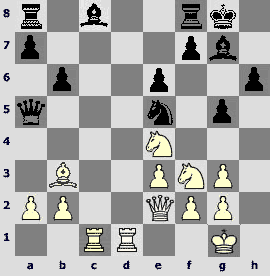






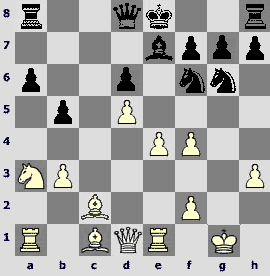

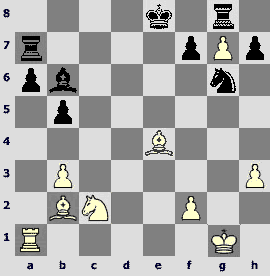






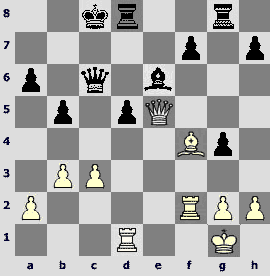
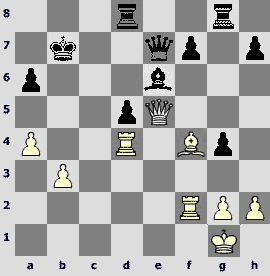




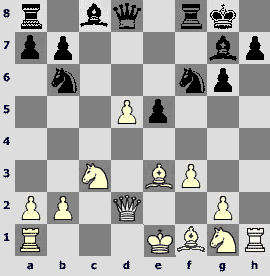


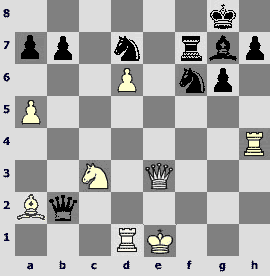


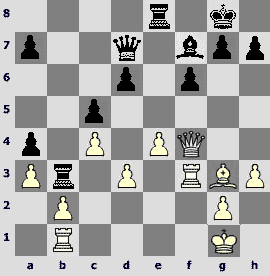



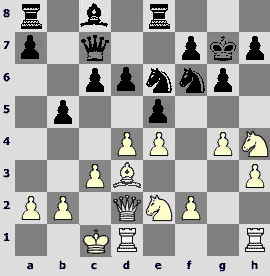



















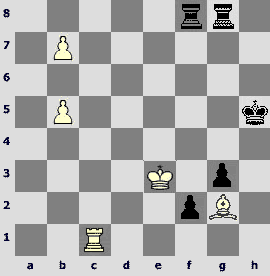












ALL ARTICLES BY AUTHOR

Discuss in forum